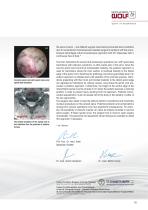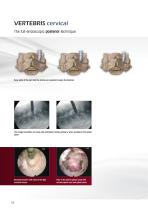
Catalog excerpts

VERTEBRIS cervical Full-endoscopic Decompression of the cervical spine posterior and anterior techniques
Open the catalog to page 1
RICHRRD nrin VERTEBRIS cervicalFull-endoscopic Spine Instrumentation spirit of excellence Contents VERTEBRIS cervical The full-endoscopic posterior technique ■ Storage i Determination of the access ■ Implementation of the access i Operating procedure The full-endoscopic anterior technique ■ Storage i Determination of the access ■ Implementation of the access i Operating procedure VERTEBRIS cervical Instrumentation ■ VERTEBRIS cervical posterior 14 i VERTEBRIS cervical anterior 16 ■ Radioblator RF 4 MHz - Multidisciplinary Radiofrequency Surgical System 20 ■ PowerDrive ART1 -...
Open the catalog to page 3
VERTEBRIS cervical Foreword In the area of the cervical spine, radicular symptoms due to degenerative causes, in other words pain in the arms, are typically caused by mediolateral to lateral spinal disk herniations or stenoses of the intervertebral foramen. At the beginning of the 1940s, the clinical symptoms of this nature with a topographical reference to changes in the cervical disks were classified for the first time. Although good results are frequently obtained using conservative methods, surgical intervention may become necessary in the presence of pain or neurological deficits. The...
Open the catalog to page 4
the spinal column - and different surgical instruments provide technical conditions akin to conventional microscopically assisted surgical inventions with the simultaneous advantages of the full-endoscopic approach with 25° telescopes with a continuous flow of fluid.1 The main indications for cervical full-endoscopic operations are "soft" spinal disk herniations with radicular symptoms, in other words pain in the arms. Since the cervical spinal cord cannot be manipulated medially, the posterior approach is used for herniations where the main section is localized laterally to the...
Open the catalog to page 5
VERTEBRIS cervical The full-endoscopic posterior technique Storage The operation is performed with the patient in the prone position lying on a hip and thorax roll. The head and the cervical spine must be resting with correct lordotic adjustment in a fixed position in keeping with a posterior intervention on the cervical spine. X-ray monitoring should be permitted during the operation in two planes. General fixation in the Mayfield Clip or a similar holder offers excellent prerequisites and always provides the circumstances for an open Prone position, fixation of the head in the Mayfield...
Open the catalog to page 6
Implementation of the access After determining the entry point in the skin and carrying out a stab incision, the dilator is inserted until contact is made with bone on the zygoapophyseal joint under lateral image intensifier control. The working sleeve with oblique opening is pushed through the dilator in a medial direction and the dilator is removed. Insertion of the dilator in the zygoapophyseal joint The operating sleeve is inserted through the dilator Operating procedure The endoscope is inserted through the working sleeve. The operation is carried out in vision using different...
Open the catalog to page 7
Bony parts of the joint and the lamina are resected to open the foramen The image intensifier can help with orientation during cutting or when working in the spinal canal Reamed foramen with view of the liga- View in the lateral spinal canal with mentum flavum cervical spinal cord and spinal nerve
Open the catalog to page 8
After removal of the lateral ligamentum flavum and exposure of the neural structures, the spinal disk herniation can be removed. The locking caps for telescope and working sleeve should only be used briefly if bleeding obscures visibility since when operations last a long time and the drainage of fluid is prevented without being noticed, the consequences of volume overload and elevated pressure within the spinal canal and the associated and neighboring structures cannot theoretically be completely excluded. Any manipulation of the spinal cord must be avoided. Experience indicates that...
Open the catalog to page 9
VERTEBRIS cervical The full-endoscopic anterior technique Storage The patient is placed in a supine position. The head and cervical spine must be placed in a slightly reclining position and fixed in keeping with an anterior approach to the cervical spine. X-ray monitoring should be permitted in two planes during the procedure. General fixation in the Mayfield Clip or a similar holder offers excellent prerequisites and always provides the circumstances for an open intervention if an emergency occurs. Particularly in the case of the lower cervical spine, it may be necessary to tape the...
Open the catalog to page 10
Implementation of the access After determining the entry point in the skin and carrying out a stab incision in the skin, the first thin dilator is inserted in the intervertebral space under lateral image intensifier control. It is important to make an anterior puncture in the spinal disk and not to miss laterally. This not only precludes further operations but can also lead to injury of the vertebral artery, spinal nerve or esophagus. Alternatively, the spinal disk can be punctured using a spinal cannula and a guide wire is inserted through this. The first dilator can then be pushed through...
Open the catalog to page 11
VERTEBRIS cervical The full-endoscopic anterior technique Operating procedure The endoscope is inserted through the working sleeve. The operation is carried out in vision using different instrument sets positioned through the intra-endoscopic working channel and with a continuous flow of liquid. On the side of the pathology, the uncinate process, posterior edge of the spine vertebral body and the posterior annulus are dissected contralaterally for purposes of topographical orientation. Bone resection with different instrument is necessary in many cases in order to reach the epidural space....
Open the catalog to page 12
Bony resection is frequently necessary to reach the spinal canal Depending on the findings, the dorsal longitudinal ligament should be opened The locking caps for the telescope and the working sleeve should only be used at short notice for hemorrhage that obscures vision because if operations extend over a long period and if the drainage of the irrigation fluid is inadvertently obstructed the consequences of volume strain and pressure increase cannot be entirely excluded within the spinal canal and the associated and adjacent structures. Any manipulation of the cervical spinal cord must be...
Open the catalog to page 13All Richard Wolf catalogs and technical brochures
-
FLUID CONTROL 2225
12 Pages
-
Catalogue Urology
466 Pages
-
Catalogue Orthopedics
218 Pages
-
Catalogue OR Integration
36 Pages
-
Catalogue Gynecology
248 Pages
-
Catalogue General surgery
222 Pages
-
Catalogue Traitement
58 Pages
-
Sterilization Basket System
8 Pages
-
ERAGON modular
28 Pages
-
LEVD
8 Pages
-
ENT catalogue
426 Pages
-
COXARTIS Brochure
12 Pages
-
BioactIF OSTEOTRANS Brochure
4 Pages
-
ERAGONbipolar Folleto
4 Pages
-
MegaPulse 70+ Flyer
2 Pages
-
RIWO-System-Tray Brochure
4 Pages
-
ERAGON
8 Pages
-
PANOVIEW ULTRA
4 Pages
-
Fiber light cables
4 Pages
-
Endocam Logic HD
12 Pages
-
ENDOCAM Performance HD
3 Pages
-
ENDOLIGHT LED
6 Pages
-
VERTEBRIS denervation
4 Pages
-
FLUID CONTROL Arthro
4 Pages
-
VERTEBRIS lumbar-thoracic
56 Pages
-
ENDOCAM Flex HD
12 Pages
-
Disposables by Richard Wolf
2 Pages
-
core nova
8 Pages
-
ZeroWire Brochure
2 Pages
-
ENDOCAM Epic 3DHD Brochure
8 Pages
-
core.media Brochure
2 Pages
-
core nova Brochure
8 Pages
-
core nova Image Brochure
2 Pages
-
Sterisafe® DURO A3
4 Pages
-
Steri Baskets Prospekt
8 Pages
-
Eragon Modluar Mini
8 Pages
Archived catalogs
-
Ultra Thin Uretero-Renoscope
2 Pages
-
T-Lock OSTEOTRANS
6 Pages
-
FLUID CONTROL LAP Brochure
2 Pages
-
COMBIDRIVE EN Brochure
20 Pages
-
TipControl Brochure
4 Pages
-
PowerDrive ART1 Brochure
8 Pages
-
arthroLution Folleto
4 Pages
-
RECTO PUMP Brochure
2 Pages
-
Sterisafe DURO A3 Brochure
4 Pages
-
VictOR HD Brochure
6 Pages
-
Reprocessing baskets
2 Pages
-
B 785 Titanium Clip GB VII13
2 Pages
-
B 774 Key Port I13 GB
12 Pages
-
B 775 LEVD XI12 GB
6 Pages
-
B 778 Lap Bergebeutel I13 GB
2 Pages
-
B 784 Eragon axial GB II13
4 Pages
-
B 920 TEM D GB VI10
18 Pages
-
B 760 ERAGON bipolar GB VI10
4 Pages
-
B 770 ERAGON compact GB VI11
12 Pages
-
B 772 Minilap GB IV11
4 Pages
-
B 773 ERAGON modular GB VII11
12 Pages



![Catalogue [Translate to English:] Disposables Urology](https://img.medicalexpo.com/pdf/repository_me/78958/catalogue-translate-to-english-disposables-urology-196889_1mg.jpg)









































































